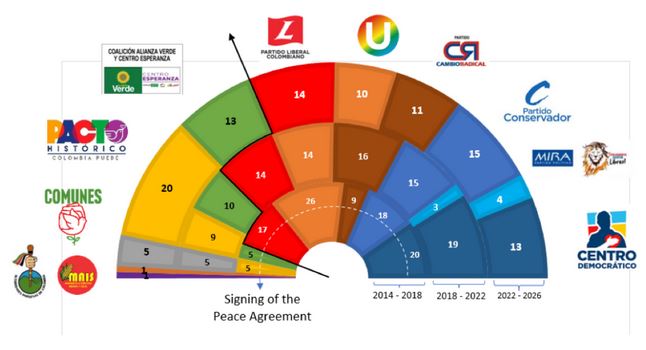

In Colombian political debate, the Revolutionary Armed Forces of Colombia (FARC) were presented as the number one enemy of the country and the cause of all social problems[1]. Since they were the largest active guerrilla, national politics used to revolve around the, let's say, "FARC problem". Their abandonment of weapons, through the Peace Agreement reached in November 2016, is a milestone with effects in the distribution of power.

Graphic 1. The black arrow shows the growth of alternative forces in the Senate of Colombia from 2014 to 2022. The internal halfmoon presents the legislature of 2014, the middle one the composition for 2018 and the external exposes the results of 2022. Own elaboration based on data from the National Civil Registry Office.
While the 2014 elections were focused on giving or not continuity to the peace talks with FARC, and the 2018 discussions on whether or not rolling back the agreement achieved, this year's elections are the first ones where the Peace Agreement is not a political option but a public policy. As a result, Colombia chose the Congress with the most plural composition and the greatest balance of forces in the 21st century.
After its signing, the Peace Agreement had an indirect effect on the growth of alternative political forces that used to be a minority (graphic 1). In fact, for 2022 legislative election the center-left2 alliance Pacto Histórico was the most voted list: Something never seen in a country traditionally leaning to the right. Other indirect impact of the Agreement is seen in the loss of strength of the government's party Centro Democrático; their anti-FARC discourse is having troubles now that this armed actor left the fray and lost prominence in the political arena. Their force is also affected by the image of the actual president, Iván Duque, whose margins of approval are the lowest that a president has had (Invamer, 2021).
The Peace Accord had also direct impacts on political plurality by guaranteeing 10 temporary seats in the Congress to Comunes —the political party created by former FARC3— and 16 Transitory Peace Circumscriptions (CITREP) in the Chamber of Representatives, designed to increase the participation of the regions more affected by war. Moreover, the Agreement committed the State with the creation of measures to achieve democratic openness.
However, accomplish this quest has serious challenges. For instance, more than half of the population is still not represented in the Congress because they do not even go to vote. Furthermore, although the Election Observation Mission of the European Union in Colombia welcomed the creation of the 16 CITREP, it expressed concerns about the "security, financing and infiltration by political parties and armed groups that make it difficult to achieve the objectives for which they were conceived"4.
Nevertheless, even if its implementation is weak and Colombian conflict is not over, directly and indirectly, the Peace Agreement is having positive impacts on democratic plurality.
References
Invamer. (april and may of 2021). Medición # 142. Link
López de la Roche, F. (2014). Las ficciones del poder: Patriotismo, medios de comunicación y reorientación afectiva de los colombianos bajo Uribe Vélez (2002-2010). Bogotá: IEPRI-Penguin Random House.
Mission of Electoral Observation of the European Union in Colombia. (15 de march de 2022). Colombia celebra una elección legislativa transparente con unas curules de paz innovadoras pero deficientes. Bogotá, Colombia. Link
1 A deeper analysis on this matter can be consulted in the book of Professor Fabio López de la Roche (2014).
2 Some media talks about the Pacto Histórico as a left-wing alliance. However, they are a coalition of multiple forces that integrates, among others: former communists, former sympathizers or the far-right ex-president Álvaro Uribe, unionists, and Christian leaders. Therefore, for this text I refer to them as center-left, instead of simple left.
3 Five in the Senate and five in the Chamber of Representatives.
4 Election Observation Mission of the European Union in Colombia (2022)